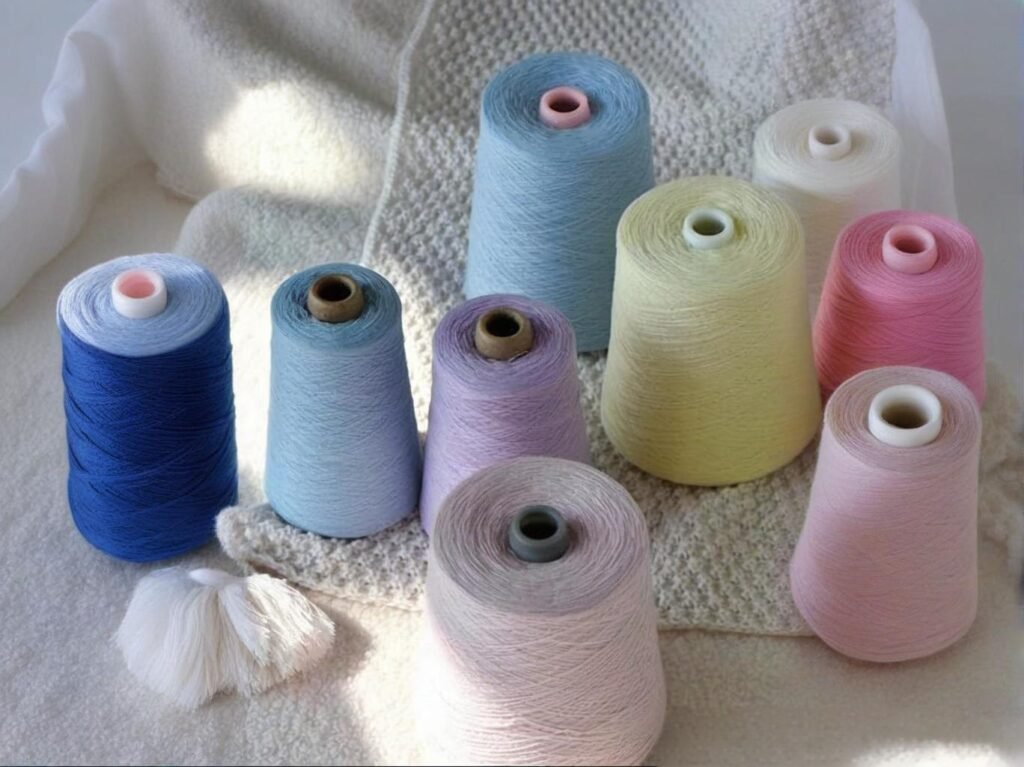Outdoor fabrics have one job—stand strong when the weather doesn’t. From sun-drenched patios to salt-laden marinas and rainy cafés, the textile needs to be durable, vivid, and dependable. While cotton canvas and polyester once dominated this space, acrylic fabric is now leading the charge thanks to its superior weather resistance, vibrant color retention, and versatility across applications.
Acrylic fabric is ideal for outdoor use because it resists UV damage, moisture, mildew, and temperature extremes. Its solution-dyed versions maintain color for years under sunlight, while its inherent hydrophobic properties make it fast-drying and mildew-resistant—ideal for cushions, awnings, marine covers, and more.
At SzoneierFabrics, we’ve helped international clients switch from polyester blends to solution-dyed acrylic for patio furniture, achieving 5X fade resistance and 40% longer outdoor lifespan. In this article, we’ll unpack the science behind acrylic’s weatherproof qualities, how it compares with other materials, and how sourcing teams can specify the right fabric for their climate zones and applications.
What Makes Acrylic Fabric Suitable for Outdoor Applications?

Acrylic fabric is well-suited for outdoor use due to its synthetic molecular structure, which resists UV light, dries quickly, repels mildew, and maintains shape and color in high-heat and cold conditions.
Why Acrylic Performs So Well Outside
1. Chemical Composition Built for Tough Environments
- Acrylic fibers are made from polyacrylonitrile, a synthetic polymer that is naturally hydrophobic, UV-stable, and thermally insulating.
- Unlike cotton or viscose, it doesn’t swell when wet and won’t rot or degrade under prolonged humidity.
2. Key Physical Properties of Outdoor Acrylic
| Property | Performance |
|---|---|
| UV Resistance | Excellent (Grade 6–7 in ISO 105-B02) |
| Water Repellency | Naturally hydrophobic; easily enhanced |
| Mildew Resistance | Doesn’t support mold growth |
| Colorfastness | Very high when solution-dyed |
| Thermal Tolerance | Withstands -20°C to +90°C without damage |
3. Stability and Shape Retention
- Acrylic does not warp or sag easily under tension
- It maintains dimensional stability through daily exposure to sun, wind, and moisture cycles
4. Common Industry Applications
| Sector | Outdoor Product Type |
|---|---|
| Hospitality | Umbrellas, cushions, cabana drapes |
| Marine | Boat covers, sail bags, upholstery |
| Residential | Awnings, outdoor furniture, pergola covers |
| Retail/Café | Canopies, branded seating, shade panels |
SzoneierFabrics Use Case: A U.S. café chain sourced solution-dyed acrylic from us for its branded umbrellas. The umbrellas lasted over 3 years with minimal fading, even under the intense Arizona sun. The project helped the client cut replacement costs by 50% year over year.
How Does Acrylic Fabric Resist UV Rays, Rain, and Temperature Extremes?
Acrylic fabric resists UV rays through its stable molecular backbone and deep-dye technology. It resists rain by repelling water naturally and dries faster than most natural fibers. Its resistance to heat and cold makes it ideal for year-round exposure in varied climates.
Environmental Resistance Explained by Test Results
1. UV Light Resistance – Key to Long-Term Color
| Material Type | ISO 105-B02 Lightfastness Grade (1–8) |
|---|---|
| Cotton Canvas (dyed) | 2–3 (poor) |
| Polyester (surface-dyed) | 4–5 (moderate) |
| Solution-Dyed Acrylic | 6–7 (excellent) |
- Acrylic doesn’t degrade or yellow in UV the way polyester and nylon can
- Solution dyeing involves coloring the fiber during its liquid state, embedding pigment throughout the strand
- This prevents surface fading, even under 1,500+ hours of UV exposure (QUV test)
2. Water and Rain Resistance
| Fabric Type | Water Absorption (%) | Dry Time (Hours) |
|---|---|---|
| Cotton Canvas | 15–25% | 3–5 hours |
| Polyester Oxford | 8–12% | 1.5–2 hours |
| Acrylic (raw) | 4–7% | \~1 hour |
| Acrylic (coated) | <1% | <30 minutes |
- Uncoated acrylic resists light rain naturally
- With Teflon® or PU coatings, acrylic becomes nearly waterproof
3. Resistance to Heat and Cold
- Doesn’t stiffen in winter like PVC or PU
- No deformation or melting until \~160–190°C
- Holds tension well without wrinkling in cold, unlike vinyl
4. Real-World Endurance Testing: SzoneierFabrics Example
| Test | Acrylic Result |
|---|---|
| QUV Accelerated Aging | Passed 1500 hrs with <5% fade |
| Water Spray Test (ISO 4920) | Grade 4–5 (very good water resistance) |
| Heat Shrinkage at 85°C | <1.2% change after 5 hrs exposure |
| Cold Crack Resistance (-20°C) | No cracking or delamination |
Is Acrylic Fabric Better Than Polyester or Canvas for Outdoor Use?

Yes—acrylic fabric offers better UV resistance, color retention, and mildew protection than polyester or canvas, making it more suitable for long-term outdoor use, especially in high-sun or humid environments.
Comparing Acrylic, Polyester, and Canvas in Outdoor Conditions
1. Side-by-Side Performance Table
| Feature | Acrylic | Polyester | Cotton Canvas |
|---|---|---|---|
| UV Resistance | ✅ Excellent (Grade 6–7) | ⚠️ Moderate (Grade 4) | ❌ Poor (Grade 2–3) |
| Color Retention | ✅ Superior (solution dyed) | ⚠️ Good if coated | ❌ Fades quickly |
| Water Resistance | ✅ Naturally repellent | ⚠️ Needs coating | ❌ Absorbs moisture |
| Mildew Resistance | ✅ Excellent | ⚠️ Moderate | ❌ Mold-prone |
| Breathability | ✅ Moderate | ❌ Low | ✅ High |
| Eco-Friendliness | ⚠️ Synthetic (REACH compliant possible) | ⚠️ Synthetic | ✅ Biodegradable |
| Maintenance | ✅ Easy clean | ⚠️ Prone to static | ❌ Requires reproofing |
| Cost (per yard, avg.) | \$\$ Mid-high | \$ Low-mid | \$\$ Mid |
2. UV Resistance Comparison
| Fabric Type | Fading After 1000h QUV | Notes |
|---|---|---|
| Acrylic (solution dyed) | ΔE < 2 (virtually none) | Best-in-class for lightfastness |
| Polyester (dyed) | ΔE \~5–6 | Starts showing visible fading |
| Cotton Canvas (dyed) | ΔE > 10 | Major discoloration or yellowing |
3. Application Lifecycle Expectations
| Product Type | Expected Outdoor Lifespan |
|---|---|
| Acrylic (uncoated) | 3–5 years depending on exposure |
| Acrylic (coated) | 5–8 years in commercial environments |
| Polyester | 1.5–3 years (with UV inhibitor) |
| Canvas | 1–2 years (if untreated) |
4. Sustainability and Maintenance Considerations
- Acrylic can meet REACH and OEKO-TEX® standards when properly produced
- Polyester may be recyclable but has lower fade resistance
- Canvas is natural, but requires frequent reproofing and degrades quickly in rain-prone regions
SzoneierFabrics Buyer Insight: A European tent company previously used PU-coated polyester for shade panels. After repeated customer complaints about fading and mildew, they switched to solution-dyed acrylic from us. Not only did customer satisfaction increase 40%, but the brand was also able to market UV durability as a premium selling point.
Which Outdoor Products Commonly Use Acrylic Textile?
Acrylic textile is widely used in outdoor products such as awnings, patio umbrellas, marine covers, sun loungers, pergola drapes, and café furniture cushions—especially where sun, rain, and mildew are concerns.
Industry-Specific Acrylic Applications
1. Residential Outdoor Products
| Product | Why Acrylic Is Ideal |
|---|---|
| Patio cushions | UV stability, softness, mildew resistance |
| Sun umbrellas | Bright color retention, weatherproof options |
| Pergola drapes | UV-dyed drape with excellent hang |
| Outdoor bean bags | Breathable, fast-drying, soft to touch |
2. Hospitality & Commercial Outdoor Use
| Application | Acrylic Benefit |
|---|---|
| Café/restaurant seating | Brand-safe color holding, easy cleaning |
| Branded umbrellas | Dye stability for logos under sunlight |
| Poolside furniture | Chlorine resistance with proper coating |
| Event tents | Flame-retardant coatings available |
3. Marine & Nautical Applications
| Use Case | Environmental Stress | Acrylic Role |
|---|---|---|
| Boat covers | UV + saltwater + mildew | Acrylic holds shape and color best |
| Sail bags | Abrasion + wet/dry cycle | Lightweight but durable performance |
| Yacht upholstery | Comfort + fade resistance | Solution-dyed versions ideal |
4. Retail/Brand Activation Spaces
- Acrylic is perfect for custom outdoor displays where color consistency and durability matter
- Easily printable or woven into custom jacquards with long-lasting brand visuals
Case Study – SzoneierFabrics Project A South African winery outfitted its tasting patio with acrylic upholstered lounge furniture and sunshades. After 2 years of intense sun and seasonal storms:
- No fading on the bordeaux red color
- Customers complimented the seating comfort
- Winery reordered the same collection for its second location
How Long Does Acrylic Fabric Last Outdoors Without Fading or Degrading?

High-quality acrylic fabric can last 5 to 10 years outdoors without significant fading or fiber breakdown, especially when solution-dyed and treated with UV and water-repellent finishes. Its longevity depends on sun intensity, humidity, fabric weight, and maintenance.
Acrylic’s Real-World Outdoor Lifespan by Use Case
1. Lifespan by Exposure Zone
| Climate Type | Daily UV Exposure | Expected Acrylic Lifespan |
|---|---|---|
| Tropical (e.g., Thailand, Florida) | High | 4–6 years (uncoated), 6–8 years (coated) |
| Temperate (e.g., Germany, Oregon) | Moderate | 6–8 years uncoated, 8–10+ years coated |
| Arid (e.g., UAE, Australia) | Intense + Dry | 5–7 years with coating |
| Coastal (e.g., Spain, California) | UV + Salt Air | 4–6 years uncoated, 6–8 years coated |
2. Fabric Type vs. Longevity
| Fabric Type | Outdoor Life (Avg) | Fade Grade Over Time (ISO 105-B02) |
|---|---|---|
| Solution-dyed acrylic | 7–10 years | Grade 5 after 1500 hrs QUV |
| Coated polyester | 2–4 years | Grade 3–4 after 1000 hrs QUV |
| Cotton canvas (treated) | 1–2 years | Grade 2–3 within 6 months |
3. Maintenance and Use Factors Affecting Lifespan
- Proper storage during off-season extends usable years
- Routine cleaning (monthly) prevents mildew and staining
- Avoiding constant friction on high-touch areas preserves finish
- Covering furniture during storms improves product life
4. SzoneierFabrics Field Feedback – Italy
A luxury resort on Lake Como used SzoneierFabrics’ solution-dyed acrylic for outdoor daybeds and umbrellas. After 5 years of lakeside sun, wind, and humidity:
- Color fade was <8% (ΔE < 2.3 measured)
- No visible pilling or sagging
- Fabric tensile strength still above 85% of original
What Coatings or Finishes Improve Acrylic’s Outdoor Performance?
Performance coatings such as UV stabilizers, water repellents (DWR), anti-mildew treatments, and stain-resistant finishes significantly enhance acrylic’s ability to resist environmental wear and maintain cleanability in outdoor use.
How to Engineer Outdoor-Grade Acrylic
1. Common Outdoor Coatings for Acrylic
| Coating Type | Performance Benefit | Applied On |
|---|---|---|
| UV Stabilizer | Boosts lightfastness and fiber integrity | Yarn or fabric |
| Teflon® or DWR Finish | Enhances water and oil repellency | Topical surface coating |
| Anti-Mildew Agent | Inhibits fungal growth in humid areas | Backing or entire fabric |
| Anti-static Coating | Prevents lint, improves cleaning ease | Often combined with DWR |
| Fire Retardant (FR) | FMVSS 302 or CPAI-84 compliance | Camping, tent, or hospitality use |
2. Comparison of Coated vs. Uncoated Acrylic
| Property | Uncoated Acrylic | Coated Acrylic (Treated) |
|---|---|---|
| Water Resistance | Moderate | High (Grade 4–5 ISO 4920) |
| UV Degradation | Low after 3 years | Very low after 5–8 years |
| Mold Growth | Possible if wet long | Minimal with anti-mildew |
| Cleanability | Needs mild soap | Resists stains, easier wipe-off |
3. Layering Options for High-Demand Environments
- Double-coated acrylic for tents and marine-grade covers
- PU backing for waterproofing with added tear resistance
- Foam-laminated acrylic for thermal padding or noise insulation
4. SzoneierFabrics Production Capabilities
| Service Available | Technical Details |
|---|---|
| Water-repellent coating | DWR (C6 fluorocarbon or non-PFC alternatives) |
| Anti-fungal treatment | ISO 846 certified |
| UV + dye bath stabilization | ISO 105-B02 Grade ≥6 |
| Fire retardant options | CPAI-84, NFPA 701 available upon request |
5. Case Example – Middle East Desert Resort
SzoneierFabrics supplied a UAE-based glamping resort with FR-treated, UV-stabilized, and DWR-coated acrylic fabric for their tent roofs and sunshade curtains.
- Fabric held color for 6+ years in 45°C+ conditions
- Passed CPAI-84 fire standard required for the hospitality sector
- Clients noted significant reduction in dust staining compared to their previous canvas materials
Do Acrylic Outdoor Fabrics Meet International Standards for Weather Resistance?

Yes—when produced correctly, acrylic outdoor fabrics meet or exceed global standards for UV resistance, colorfastness, water repellency, mildew resistance, and flame retardancy. They are tested under ISO, ASTM, and industry-specific protocols for export and OEM approval.
Key Standards Acrylic Fabrics Should Comply With
1. UV & Lightfastness Testing
| Standard | Description | Acrylic Benchmark |
|---|---|---|
| ISO 105-B02 | Colorfastness to artificial light | Grade 6–7 (excellent) |
| AATCC TM16 | US version of lightfastness test | Grade ≥5 after 1500h QUV |
| SAE J1885 | UV test for automotive interiors | Often used for marine/awning too |
2. Water & Weather Resistance
| Standard | Description | Acrylic Benchmark |
|---|---|---|
| ISO 4920 (Spray Test) | Water repellency surface test | Grade 4–5 after coating |
| ISO 811 (Hydrostatic Head) | Measures waterproof level | 100–300 mm without coating, up to 1000+ mm with PU backing |
3. Mold, Mildew, and Microbial Growth
| Standard | Description | Acrylic Benchmark |
|---|---|---|
| ISO 846 | Anti-fungal/bacterial resistance | Pass with biocide finish |
| AATCC 30 | Mildew resistance (US standard) | Pass when treated |
4. Flame Retardant Testing (if needed)
| Standard | Application | Compliance via |
|---|---|---|
| CPAI-84 | Camping textiles and tents | Acrylic with FR additive or coating |
| NFPA 701 | US commercial interiors | FR-treated acrylic available |
| FMVSS 302 | Automotive interiors | Modacrylic or blend with FR finish |
5. OEKO-TEX® and REACH Compliance
- OEKO-TEX® Standard 100 ensures fabrics are free from harmful chemicals for skin contact
- REACH ensures environmental and health compliance in EU-regulated markets
- Acrylics can meet both when responsibly sourced and manufactured—SzoneierFabrics guarantees both upon request
Certification Example: SzoneierFabrics
| Certification | Status |
|---|---|
| ISO 9001 | ✅ Quality Management Systems |
| OEKO-TEX® | ✅ For yarns and finished fabrics |
| CPAI-84 (on request) | ✅ Custom FR-treated outdoor acrylic |
| ISO 105/4920/12947 | ✅ All standard tests in-house available |
How Can B2B Buyers Source High-Performance Outdoor Acrylic Fabric?
B2B buyers can source high-quality outdoor acrylic fabric by working with certified manufacturers who offer solution-dyed yarns, weather-resistant finishes, full testing documentation, low MOQ flexibility, and fast development timelines.
A Proven Sourcing Strategy for Acrylic Outdoor Fabric
1. Define Key Requirements Based on Application
| Application Area | Required Properties |
|---|---|
| Outdoor cushions | UV resistance, mildew-proof, soft touch |
| Marine covers | Salt + water repellency, tensile strength |
| Umbrellas/awnings | Fade-proof, shape retention, color options |
| Hospitality tents | Fire retardancy, easy cleaning, durability |
2. Request the Right Fabric Specs
| Spec to Request | Ideal Range |
|---|---|
| GSM | 180–350 GSM for most outdoor use |
| Lightfastness | Grade 6+ (ISO 105-B02) |
| Spray Test (ISO 4920) | Grade 4 or above |
| Color method | Solution dyed (not surface dyed) |
| Mold resistance | ISO 846 / AATCC 30 Pass |
3. Evaluate Manufacturer Capability
| What to Ask for | Why It Matters |
|---|---|
| Yarn-to-finish traceability | Ensures consistency and compliance |
| In-house lab testing | Faster turnaround, reliable data |
| Coating and dye customization | Matches branding and performance needs |
| MOQ flexibility and global shipping | Supports both brands and wholesalers |
4. Sampling and Testing
- Ask for cut swatches (50cm²) with certification copies
- Test under local sunlight and spray or rub simulations
- Ensure batch consistency before bulk production
Source Outdoor-Grade Acrylic Fabrics from SzoneierFabrics
With over 18 years of experience, SzoneierFabrics supplies OEMs, brands, retailers, and hospitality clients worldwide with performance acrylic fabrics engineered for the outdoors.
Why Choose Us:
- ✅ Solution-dyed acrylic with OEKO-TEX® certification
- ✅ Anti-UV, water-repellent, mildew-proof, and fire-retardant options
- ✅ In-house testing (ISO, AATCC, CPAI-84) and full export compliance
- ✅ Low MOQ starting at 50 meters, fast sample lead time (5–7 days)
- ✅ Custom patterns, digital prints, and coatings available
- ✅ Support for brand launches, resellers, and long-term supply chains
Start your outdoor fabric sourcing journey now:
From sun-soaked decks to rainy retreats—our outdoor acrylics stand up to the elements. Let’s build your weatherproof collection.

